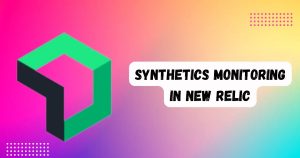
In the ever-evolving digital landscape, ensuring the seamless performance and reliability of your applications is a top priority. Synthetic monitoring has emerged as a vital practice that allows you to proactively detect and address potential issues before they impact your users. New Relic, a renowned application performance monitoring tool, offers a comprehensive suite of features to assist you in achieving these goals. In this guide, we’ll take you through the process of getting synthetics monitoring to work effectively in New Relic, step by step.
Understanding Synthetic Monitoring
What is Synthetic Monitoring?
Synthetic monitoring involves the simulation of user interactions with your application using predefined scripts. These scripts mimic real user behavior, allowing you to monitor various aspects of your application’s performance.
Why is Synthetic Monitoring Important?
Synthetic monitoring provides insights into how your application performs from different locations and user scenarios. By proactively identifying bottlenecks and potential issues, you can ensure a positive user experience.
Getting Started with New Relic
Creating a New Relic Account
Before delving into synthetic monitoring, you need a New Relic account. If you don’t have one, visit the New Relic website and sign up for an account. Choose a subscription plan that suits your monitoring needs.
Navigating the Dashboard
Once you’re logged into your New Relic account, familiarize yourself with the dashboard. The dashboard is where you’ll manage your monitors, view performance metrics, and receive alerts.
Setting Up Synthetic Monitoring
Choosing the Right Monitors
Identify the critical user journeys within your application. These journeys will serve as the foundation for your synthetic monitors. Decide whether you need single-page monitors for specific pages or multi-step transaction monitors for complex user flows.
Configuring Monitor Locations
For accurate insights, distribute your synthetic monitors across different geographic locations. This helps replicate real-world user experiences and assess performance from various regions.
Creating Synthetic Monitors
Single-Page Monitors
Single-page monitors focus on individual pages or URLs within your application. These monitors are particularly useful for tracking response times and the availability of specific pages.
Multi-Step Transaction Monitors
If your application involves multi-step interactions (e.g., signing up, adding items to a cart, checking out), consider using multi-step transaction monitors. These monitors simulate complete user journeys, providing comprehensive performance data.
Defining Monitor Scripts
Understanding Scripting Language
Monitor scripts are written using scripting languages like Selenium or HTTP. These scripts outline the steps a user takes within your application.
Writing Effective Scripts
Craft accurate and comprehensive scripts that replicate user actions. Pay attention to details such as button clicks, form submissions, and waiting times to ensure realistic simulations.
Monitoring Frequency and Thresholds
Setting Monitor Intervals
Choose the frequency at which your synthetic monitors will run. Strike a balance between collecting frequent data and not overloading your application.
Defining Thresholds and Alerts
Establish performance thresholds for your monitors. When metrics breach these thresholds, you’ll receive alerts, enabling you to take prompt action.
Analyzing Synthetic Data
Interpreting Performance Metrics
Once your synthetic monitors are operational, analyze performance metrics such as response time, load time, and error rates. These insights offer a clear view of your application’s health.
Identifying Trends and Anomalies
Regularly review the collected data to identify trends and anomalies. Address any deviations promptly to maintain optimal user experiences.
Troubleshooting and Optimization
Investigating Failures
If a synthetic monitor fails, delve into the root cause using error logs and performance data. Swiftly addressing issues is crucial for uninterrupted application performance.
Optimizing Monitor Performance
Periodically review your synthetic monitors and fine-tune them based on changing application dynamics. Adjust scripts, intervals, and thresholds as needed.
Integrating with Real User Monitoring
Correlating Synthetic and Real User Data
Combining synthetic monitoring insights with real user monitoring data provides a holistic understanding of your application’s performance.
Gaining Comprehensive Insights
Leverage New Relic’s reporting capabilities to create comprehensive dashboards that present insights from both synthetic and real user data.
Staying Ahead of Performance Issues
Using Reports and Dashboards
Regularly generate reports and dashboards to track performance trends over time. These insights guide continuous improvement efforts.
Continuous Improvement Strategies
Synthetic monitoring is an ongoing endeavor. Continuously refine your monitors and scripts to adapt to changes in your application and user behavior.
Best Practices for Synthetic Monitoring
Regularly Review and Update Monitors
As your application evolves, update your synthetic monitors to accurately reflect the latest user journeys and functionalities.
Collaborate Across Teams
Involve developers, testers, and operations teams in your synthetic monitoring efforts. Their insights can lead to more effective monitoring strategies.
Conclusion
Implementing synthetic monitoring within New Relic is a proactive approach to maintaining application performance. By establishing effective monitors, analyzing performance data, and collaborating across teams, you can ensure a seamless user experience and proactively address potential issues.
